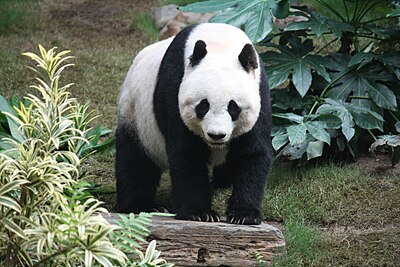- v50 information can now be added to pages in the main namespace. v0.47 information can still be found in the DF2014 namespace. See here for more details on the new versioning policy.
- Use this page to report any issues related to the migration.
Panda
|
P
| |
| Urist likes pandas for their big fluffy heads and bellies. | |
|---|---|
| Portrait | |
|
No portrait | |
| Biome | |
|
| |
| Variations | |
| Tamed Attributes | |
| Pet value | 300 |
|
| |
|
Not hunting/war trainable | |
| Size | |
| Birth: | 150 cm3 |
| Mid: | 65,000 cm3 |
| Max: | 130,000 cm3
|
| Age | |
| Adult at: | 1 |
| Max age: | 20-30 |
| Butchering returns
(Value multiplier ×2) | |
|
Food items | |
| Meat | 13 |
| Fat | 12 |
| Brain | 1 |
| Heart | 1 |
| Lungs | 2 |
| Intestines | 1 |
| Liver | 1 |
| Kidneys | 2 |
| Tripe | 1 |
| Sweetbread | 1 |
| Spleen | 1 |
|
Raw materials | |
| Bones | 18 |
| Skull | 1 |
| Teeth | 2 |
| Skin | Raw hide |
v50.12 · v0.47.05 This article is about the current version of DF.Note that some content may still need to be updated. |
- A large bear-like creature with a striking coat of black and white hair. It feeds on bamboo forests.
Pandas are large mammals found roaming alone through temperate forests. They are noted for their distinctive black and white coloration, and their dependence upon bamboo.
Pandas are fairly docile and will generally run away from dwarves. Unless they are attacked, they pose little threat. When angry, however, they are strong enough to kill an unarmed/untrained peasant.
Note that trained and tame pandas will only eat bamboo, and can easily starve unless assigned to a pasture with ample bamboo in it. The elves will not bother to mention this detail to you when they bring pandas for trade.
Pandas can be kept as livestock and bred for a meat industry, however their dietary requirements will necessitate excessive micromanagement. Their butchering returns are twice as valuable as common critters, but there are many easier and more lucrative options for livestock.

5 kph
Pandas were sponsored by the generous contributions of the Bay 12 community.
I bring pandamonium!
Vorpal
Ian
"If you can't do something fast, do it half-fast." Gwen <3 Mike
Masaka
[CREATURE:PANDA]
[DESCRIPTION:A large bear-like creature with a striking coat of black and white hair. It feeds on bamboo forests.]
[NAME:panda:pandas:panda]
[CASTE_NAME:panda:pandas:panda]
[CHILD:1][GENERAL_CHILD_NAME:panda cub:panda cubs]
[CREATURE_TILE:'P'][COLOR:7:0:1]
[CREATURE_CLASS:MAMMAL]
[PETVALUE:300]
[PET]
[NATURAL]
[STANDARD_GRAZER]
[SPECIFIC_FOOD:PLANT:BAMBOO, ARROW]
[SPECIFIC_FOOD:PLANT:BAMBOO, GOLDEN]
[SPECIFIC_FOOD:PLANT:BAMBOO, HEDGE]
[LARGE_ROAMING]
[POPULATION_NUMBER:2:3]
[CLUSTER_NUMBER:1:1]
[BIOME:ANY_TEMPERATE_FOREST]
[GRASSTRAMPLE:0]
[MEANDERER]
[PREFSTRING:striking coloration]
[PREFSTRING:big fluffy heads and bellies]
[PREFSTRING:lazy nature]
[BODY:QUADRUPED_NECK:TAIL:2EYES:2EARS:NOSE:2LUNGS:HEART:GUTS:ORGANS:THROAT:NECK:SPINE:BRAIN:SKULL:5TOES_FQ_REG:5TOES_RQ_REG:MOUTH:TONGUE:GENERIC_TEETH_WITH_LARGE_EYE_TEETH:RIBCAGE]
[BODYGLOSS:PAW]
[BODY_DETAIL_PLAN:STANDARD_MATERIALS]
[BODY_DETAIL_PLAN:STANDARD_TISSUES]
[SELECT_TISSUE:HAIR]
[INSULATION:200]
[BODY_DETAIL_PLAN:VERTEBRATE_TISSUE_LAYERS:SKIN:FAT:MUSCLE:BONE:CARTILAGE]
[BODY_DETAIL_PLAN:BODY_HAIR_TISSUE_LAYERS:HAIR]
[USE_MATERIAL_TEMPLATE:NAIL:NAIL_TEMPLATE]
[USE_TISSUE_TEMPLATE:NAIL:NAIL_TEMPLATE]
[TISSUE_LAYER:BY_CATEGORY:TOE:NAIL:FRONT]
[SELECT_TISSUE_LAYER:HEART:BY_CATEGORY:HEART]
[PLUS_TISSUE_LAYER:SKIN:BY_CATEGORY:THROAT]
[TL_MAJOR_ARTERIES]
[BODY_DETAIL_PLAN:STANDARD_HEAD_POSITIONS]
[BODY_DETAIL_PLAN:HUMANOID_RIBCAGE_POSITIONS]
[USE_MATERIAL_TEMPLATE:SINEW:SINEW_TEMPLATE]
[TENDONS:LOCAL_CREATURE_MAT:SINEW:200]
[LIGAMENTS:LOCAL_CREATURE_MAT:SINEW:200]
[HAS_NERVES]
[USE_MATERIAL_TEMPLATE:BLOOD:BLOOD_TEMPLATE]
[BLOOD:LOCAL_CREATURE_MAT:BLOOD:LIQUID]
[CREATURE_CLASS:GENERAL_POISON]
[GETS_WOUND_INFECTIONS]
[GETS_INFECTIONS_FROM_ROT]
[USE_MATERIAL_TEMPLATE:PUS:PUS_TEMPLATE]
[PUS:LOCAL_CREATURE_MAT:PUS:LIQUID]
[BODY_SIZE:0:0:150] small!
[BODY_SIZE:1:0:65000]
[BODY_SIZE:2:0:130000]
[BODY_APPEARANCE_MODIFIER:LENGTH:90:95:98:100:102:105:110]
[BODY_APPEARANCE_MODIFIER:HEIGHT:90:95:98:100:102:105:110]
[BODY_APPEARANCE_MODIFIER:BROADNESS:90:95:98:100:102:105:110]
[MAXAGE:20:30]
[ATTACK:BITE:CHILD_BODYPART_GROUP:BY_CATEGORY:HEAD:BY_CATEGORY:TOOTH]
[ATTACK_SKILL:BITE]
[ATTACK_VERB:bite:bites]
[ATTACK_CONTACT_PERC:100]
[ATTACK_PENETRATION_PERC:100]
[ATTACK_FLAG_EDGE]
[ATTACK_PREPARE_AND_RECOVER:3:3]
[ATTACK_PRIORITY:MAIN]
[ATTACK_FLAG_CANLATCH]
[ATTACK:SCRATCH:CHILD_TISSUE_LAYER_GROUP:BY_TYPE:STANCE:BY_CATEGORY:ALL:NAIL]
[ATTACK_SKILL:GRASP_STRIKE]
[ATTACK_VERB:scratch:scratches]
[ATTACK_CONTACT_PERC:100]
[ATTACK_PENETRATION_PERC:100]
[ATTACK_FLAG_EDGE]
[ATTACK_PREPARE_AND_RECOVER:3:3]
[ATTACK_PRIORITY:SECOND]
[CREPUSCULAR][NOCTURNAL]
[HOMEOTHERM:10067]
[APPLY_CREATURE_VARIATION:STANDARD_QUADRUPED_GAITS:2728:2069:1409:675:4000:5700] 13 kph
[APPLY_CREATURE_VARIATION:STANDARD_SWIMMING_GAITS:9000:8900:8825:8775:9500:9900] 1 kph
[APPLY_CREATURE_VARIATION:STANDARD_CRAWLING_GAITS:9000:8900:8825:8775:9500:9900] 1 kph
[SWIMS_INNATE]
[MUNDANE]
[CASTE:FEMALE]
[FEMALE]
[CASTE:MALE]
[MALE]
[SET_BP_GROUP:BY_TYPE:LOWERBODY][BP_ADD_TYPE:GELDABLE]
[SELECT_CASTE:ALL]
[SET_TL_GROUP:BY_CATEGORY:HEAD:HAIR]
[TL_COLOR_MODIFIER:BLACK:1]
[TLCM_NOUN:hair around the eyes:SINGULAR]
[SET_TL_GROUP:BY_CATEGORY:EAR:HAIR]
[TL_COLOR_MODIFIER:BLACK:1]
[TLCM_NOUN:ears:PLURAL]
[SET_TL_GROUP:BY_CATEGORY:LEG_FRONT:HAIR]
[PLUS_TL_GROUP:BY_CATEGORY:LEG_REAR:HAIR]
[PLUS_TL_GROUP:BY_CATEGORY:FOOT_FRONT:HAIR]
[PLUS_TL_GROUP:BY_CATEGORY:FOOT_REAR:HAIR]
[PLUS_TL_GROUP:BY_CATEGORY:TOE:HAIR]
[TL_COLOR_MODIFIER:BLACK:1]
[TLCM_NOUN:legs:PLURAL]
[SET_TL_GROUP:BY_CATEGORY:BODY_UPPER:HAIR]
[TL_COLOR_MODIFIER:BLACK:1]
[TLCM_NOUN:upper body:SINGULAR]
[SET_TL_GROUP:BY_CATEGORY:HEAD:HAIR]
[PLUS_TL_GROUP:BY_CATEGORY:BODY_LOWER:HAIR]
[PLUS_TL_GROUP:BY_CATEGORY:TAIL:HAIR]
[TL_COLOR_MODIFIER:WHITE:1]
[TLCM_NOUN:other hair:SINGULAR]
[SET_TL_GROUP:BY_CATEGORY:ALL:SKIN]
[TL_COLOR_MODIFIER:PINK:1] gray under the black parts I guess, but don't want to spoil descriptions with that
[TLCM_NOUN:skin:SINGULAR]
[SET_TL_GROUP:BY_CATEGORY:EYE:EYE]
[TL_COLOR_MODIFIER:IRIS_EYE_BROWN:1] have seen various musings on this, but don't have anything solid, and no good pics
[TLCM_NOUN:eyes:PLURAL]
[SELECT_MATERIAL:ALL]
[MULTIPLY_VALUE:2] |